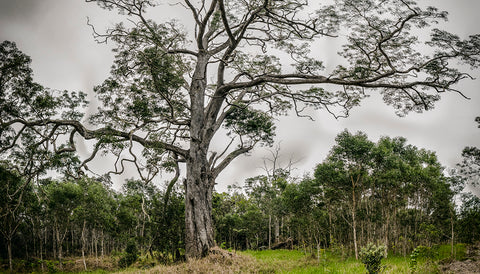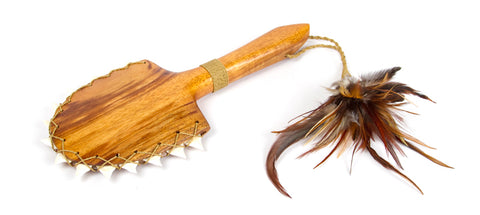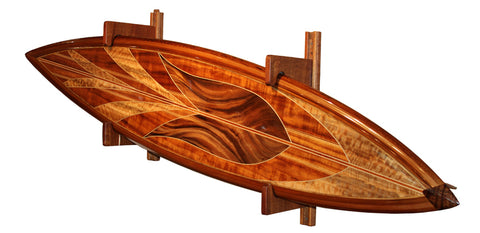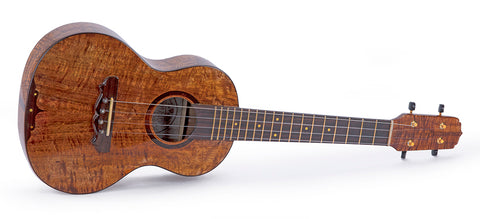About Us
Martin & MacArthur’s craftsmen have been the premier makers of koa furniture and beautiful home accessories for more than 50 years.
Founded by Jon Martin in 1961, the Company was at the forefront of reviving an appreciation for koa wood
– an exceptionally beautiful species of the acacia genus grown only in the Hawaiian Islands.
Irving Jenkins, author of a book on Hawaiian furniture and Hawai'i's cabinetmakers, calls “Martin & MacArthur the single biggest and lasting influence on the wood-crafting industry in the 20th century.”
“As the largest handcrafter of koa furnishings in the world, Martin & MacArthur has played an important role in keeping alive the traditions of classical Hawaiian furniture.”

Texas-born Jon Martin grew up building stage sets and props for his parent's theater production company. He developed his woodworking skills at
McKinley High School when the family moved to Hawai'i in the mid-1950s, and later worked with master boat-builder T. Murakami.
After serving with the Army in Korea, Martin opened a small shop building cabinets out of a Kaka'ako garage in 1961. Local businessman Douglas MacArthur joined Martin to handle the administrative and financial side of the company in return for a 50 percent stake. Martin & MacArthur began with a mission of reviving the art of fine furniture in the classic style of Hawaii.
Martin designed and built the furniture, a true master craftsman. But his strength, has always been identifying the beauty in roughhewn koa planks and matching similar or complementary pieces of wood to create beautiful furniture.
"It's the most varying wood in the world. Koa comes in all shades and a variety of beautiful grains. To me, this fancy hardwood that grows only in Hawai'i is the most magnificent wood on earth.” ….Jon Martin
Most of the few large-scale factory producers of koa furniture died out after World War II. Martin & MacArthur has been the dominant manufacturer since the 1970s.
In the 1980s, when classical Hawaiian furniture was enjoying a resurgence, Martin trained about half of all Island cabinetmakers.
“(Martin) influenced every area of the koa furniture industry in Hawai'i," Jenkins said. "Jon just has a passion for making furniture."

In 2008, Jon Martin made the decision to retire. Doug MacArthur had already moved to the Big Island to pursue his real estate career. So, Jon found the perfect owners to carry on his legacy. He sold the company to Michael Tam and Simon McKenzie.
Martin said, “Michael is a visionary and an innovator. Moreover, he understands the legacy and cultural foundation of Martin & MacArthur. Our leadership and heritage in the Hawaii market will be strengthened through his experience and insights."
Michael Tam, a graduate of St. Louis School and Northwestern University, brought extensive executive leadership experience from a range of companies, including Starbucks, Nordstrom, American Eagle Outfitters,
McDonald's and Borders Bookstores, where he was senior vice president and chiefmarketing officer.
When the company was purchased in 2008, there was the Kalihi workshop/warehouse, where all the furniture and business operations were located, in addition to three retail stores that sold home furnishings, art and hand-crafted gift items: the Hyatt Regency Waikiki, Ala Moana Center and The Shops at Wailea.
Today there are 10 stores across the Hawaiian Islands with more to come in the future.
….Michael Tam

Koa Wood is legendary in Hawaii. Not only is this amazing tree
endemic to Hawaii but it is known for its beautiful
deep rich colors and varied grain pattern.
Koa has honored heritage and is highly revered and sacred.
Koa in battle. The word “koa” means “warrior” or “strong” in Hawaiian. The warriors of King Kamehameha the Great, created canoes and weapons from a wood plentiful on the Big Island of Hawaii. This wood became synonymous with the warriors themselves, and it became known as koa.

Some of the early Hawaiian weapons were called “lei-o-mano.” These weapons were made of shark’s teeth, marlin bills, and koa wood. They were often used for hand-to-hand combat and were highly effective with
slashing and ripping the flesh in one cross-body motion, leaving the unfortunate victim eviscerated and an example of the power of the conquering warriors.
In the late 1700’s, King Kamehameha and his warriors traveled up the Hawaiian Island chain, uniting all the islands under his rule.
Undoubtedly, koa wood played a significant role in the great king’s quest to bring the Hawaiian Islands together.
Koa for the masses. In years that followed, koa wood was already so highly regarded that is was “kapu” or prohibited for anyone to possess koa wood except the Hawaiian monarchs and ali’i royalty class. After the great king’s death, his widow, Kaahumanu and son Liholiho abandoned the kapu system, thus allowing all Hawaiians to possess koa wood.
Due to its widespread availability throughout the Hawaiian Islands, koa wood was used for every aspect of early Hawaiians’ life. Food was served in carve out Koa bowls called “umeke.” Cutting and carving instruments for daily living called “niho ‘oki” were made from koa and shark’s teeth. These instruments were used in the same way as today’s x-acto knives.

The first surfboards were made of koa. More importantly, koa was used to make many Hawaiian outrigger canoes for fishing, sailing, and traversing islands. In later years, “malihini” settlers from other countries introduced small stringed musical

instruments that the Hawaiians called “ukulele,” which were almost always made with koa wood.
Koa vs. Cattle. During the 1800’s, land on the Big Island was gobbled up with enterprising ranchers hoping to use these wide tracts of land to raise herds of cattle. Unfortunately, large tracts of koa forests were eliminated to make way for grazing cattle.
North of Hilo, Hawaii, there is an area now called umikoa, which was once a dense koa forest owned by King Kamehameha the Great. Unfortunately, almost all the koa trees were eliminated for herds of cattle that roamed the region. Additionally, other livestock introduced to Hawaii, including pigs and goats, would graze on young koa seedlings before they had a chance to mature.
Very often, fences used to separate plantations on the Big Island were built from Koa. This was before westerners or “malihini” came to regard Koa as a beautiful resource.
Koa Continues. In spite of decades of without attention or regard, today koa continues to grow on all Hawaiian Islands, particularly the Big Island. The rich volcanic soil of this largest, youngest island yields koa that is particularly dark and red. The most beautiful koa wood as a wavy, fluttering cross-grain pattern called “curly,” which is sometimes referred to as fiddle back. Only 10% of all koa is “curly.”

Today, Koa is so highly regarded for its beauty, that land owners find it a profitable revenue source, even more so than cattle. All koa harvested from the Big Island comes from previously dead and fallen trees. The State of Hawaii and plantation landowners are very strict about the harvesting of Koa and self-regulation is the standard practice.
Koa has never been regarded as an endangered species, and it is certainly far from extinct. Due to self-management and the partnership of private and State interests, there is more koa growing in Hawaii now that 10 or 20 years ago. Koa is the second most populous tree in Hawaii.

Green and Growing. Koa trees have a natural life cycle of about 50-80 years due to the natural rot and decay that occurs to the trees over time. If you ever have a chance to visit the mid-elevations on the Big Islands, you will see that the circle of life continues as new koa trees are growing amidst trees that have naturally died and fallen.
Big Island landowners today do not cut down any live koa trees. On the contrary, when fallen koa trees are removed from the mid-level elevations, new koa seedlings are quick to sprout. Today, the fences keep the cattle and pig out of the areas where new koa trees are growing. Ironically, the fences once erected to keep cattle within boundaries are now erected to keep the cattle out of the areas where young koa trees are growing.
Today, the biggest user of koa wood is Martin & MacArthur, a local company that has been making fine koa furniture and home accessories in Hawaii for over 50 years, longer than any other company in the history of Hawaii.
(www.MartinandMacArthur.com) Owners of the Oahu-based company regularly go to the Big Island to hand-select the koa wood used for their gracious furniture. All the wood comes from fallen trees. In fact, Martin & MacArthur is the leader in reforesting Koa for future generations. The company was also one of the first to support the farming of Koa in the very area north of Hilo that was once the koa forest of King Kamehameha.
Koa has a rich history in the heritage of Hawaii. Fortunately, koa will remain a vital and thriving resource in Hawaii for future generations to enjoy.
